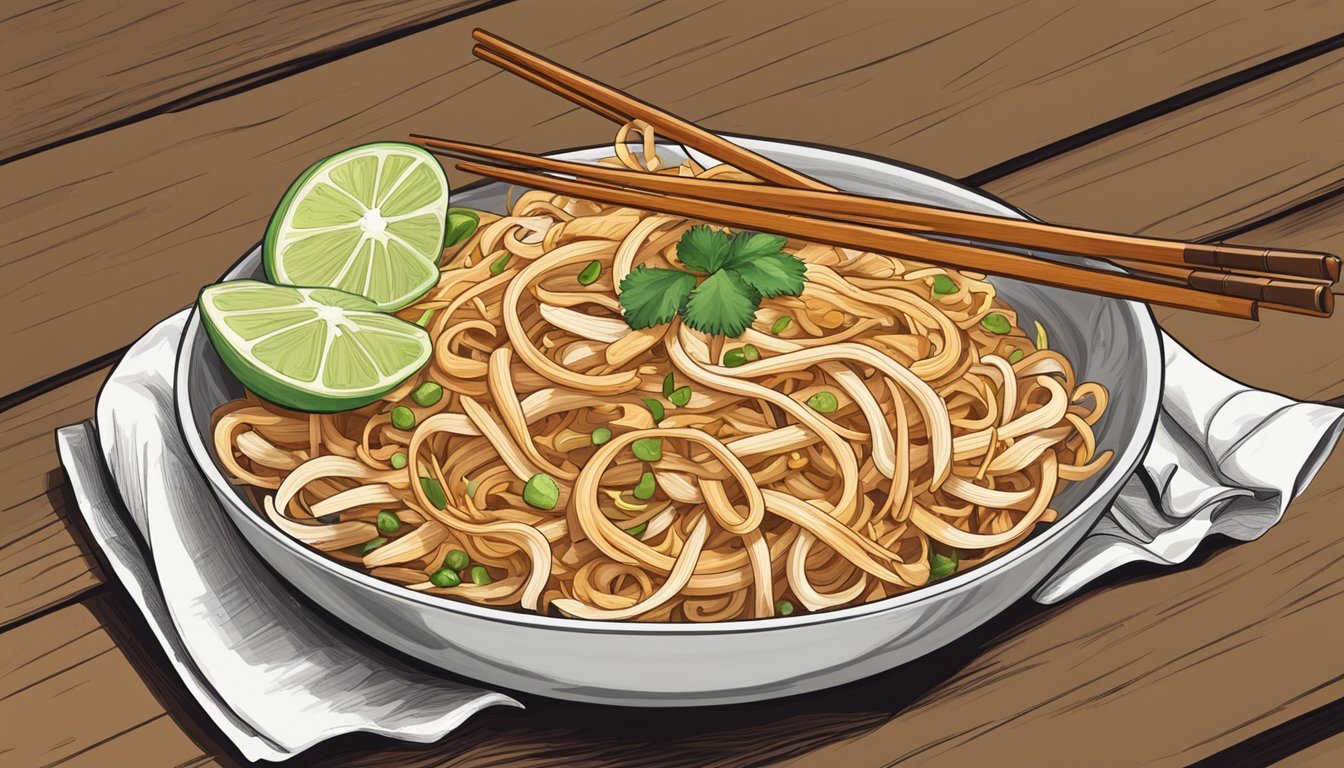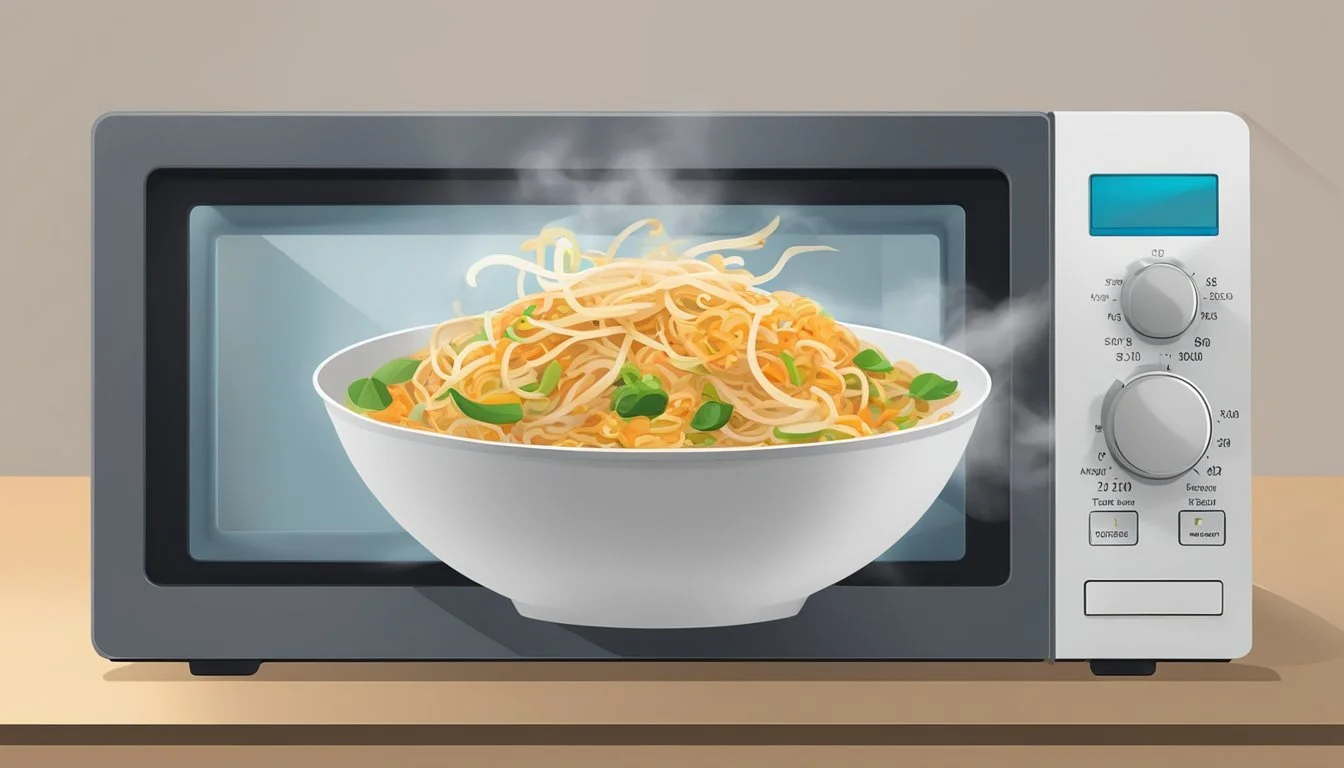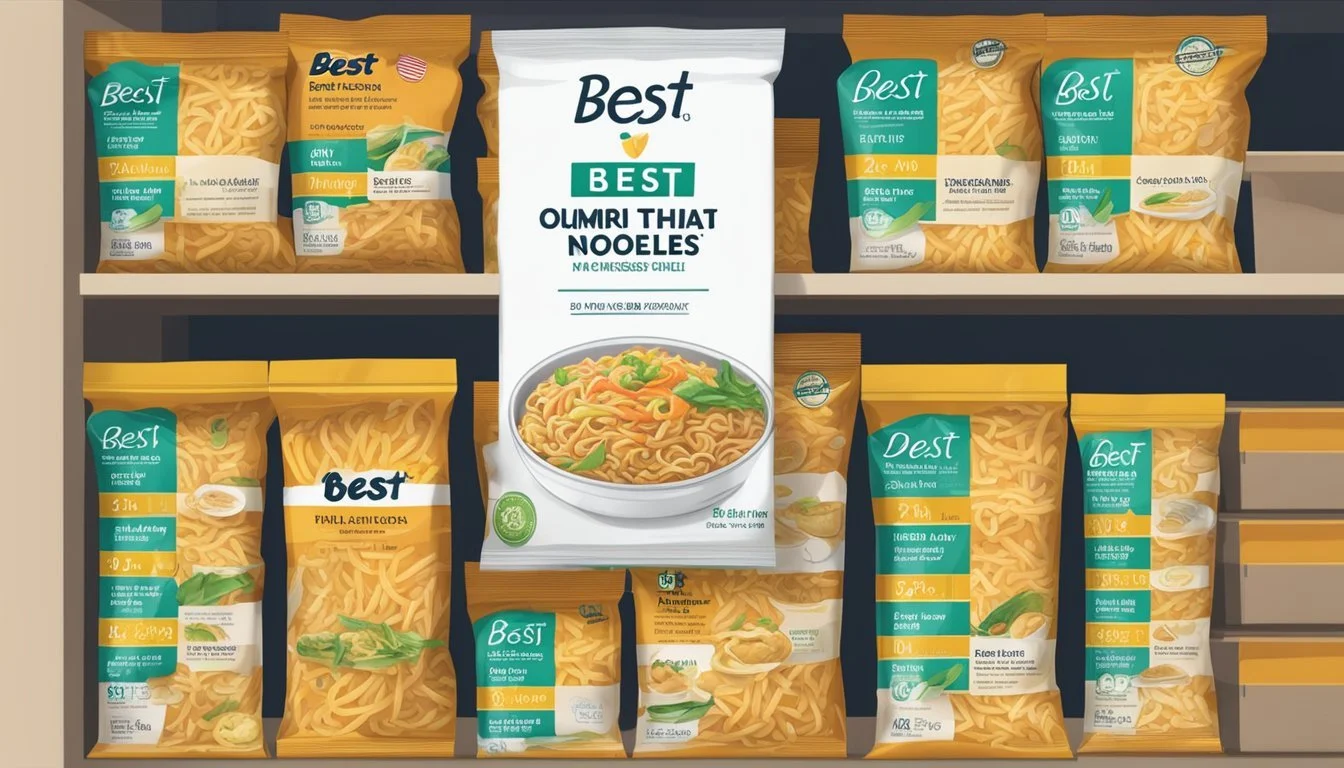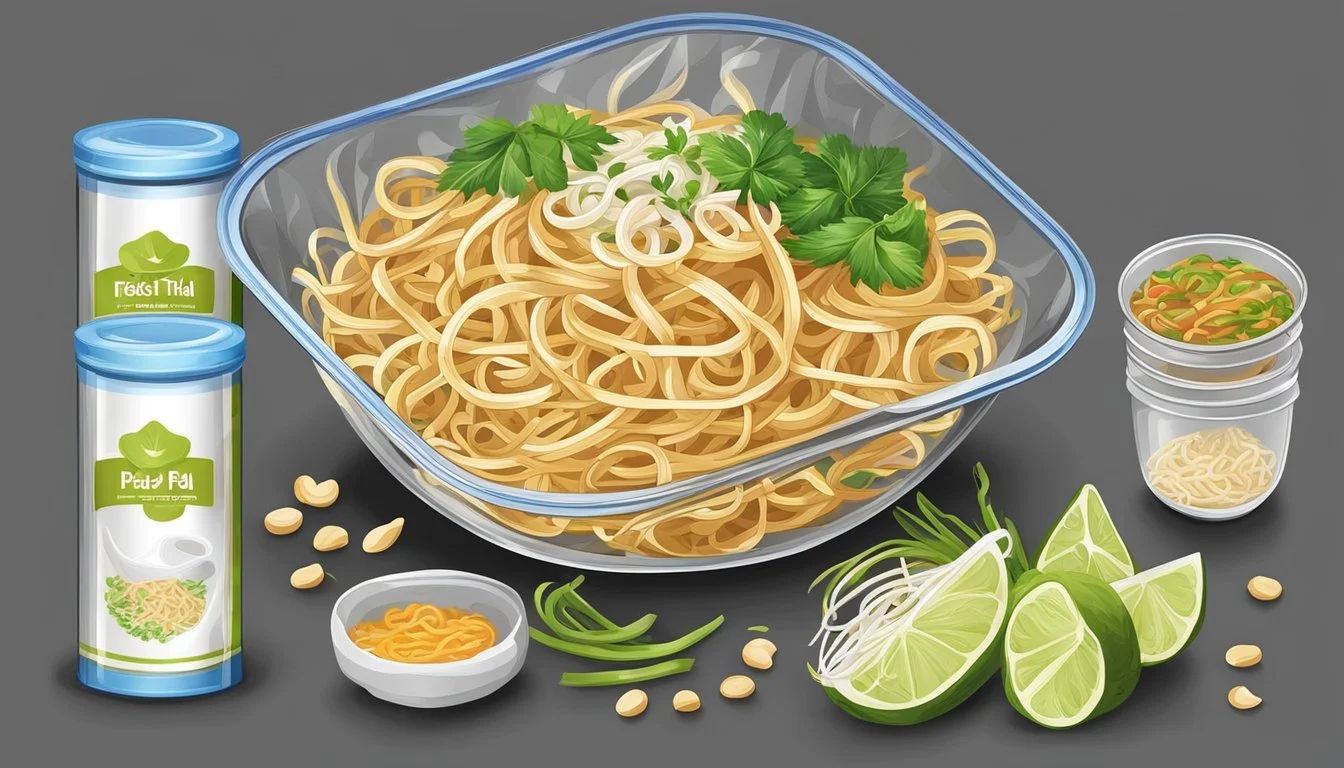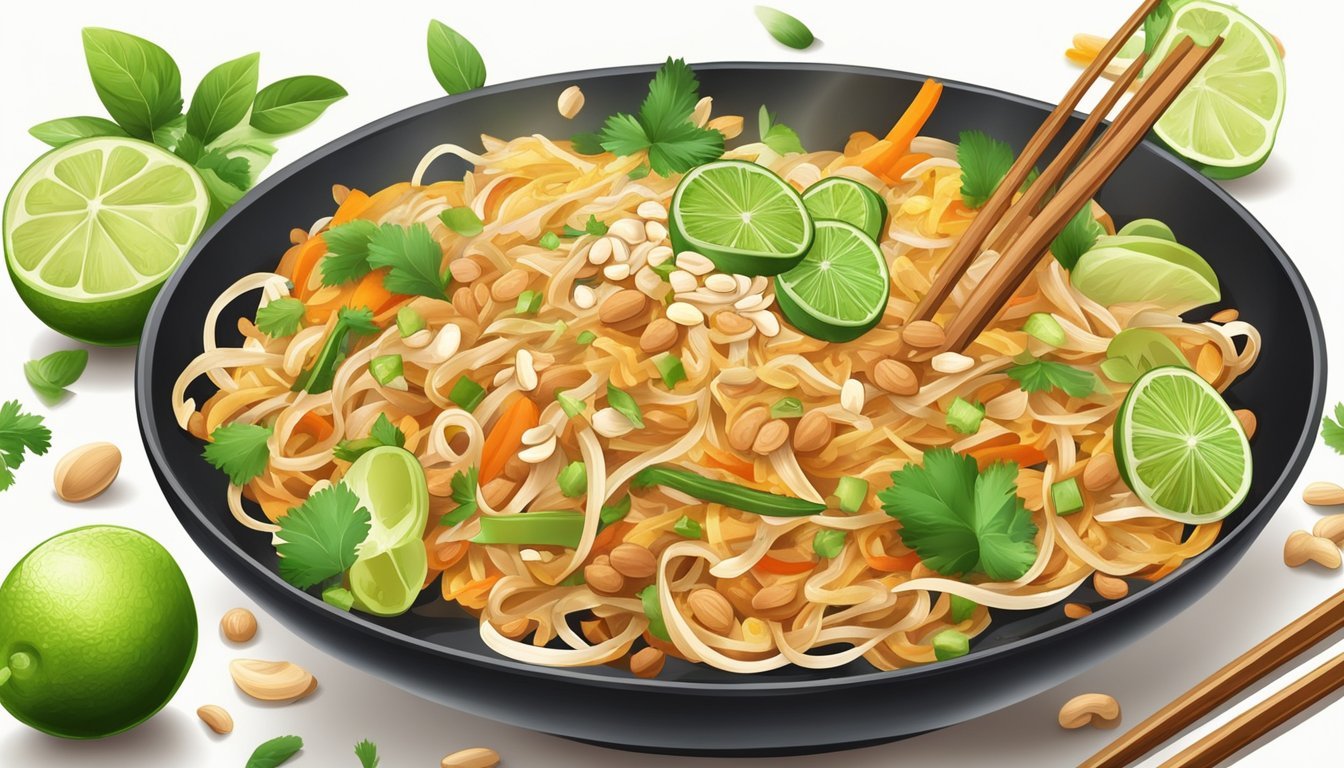How Long Do Pad Thai Noodles Last?
Shelf Life and Storage Tips
Pad Thai, the quintessential Thai street food, is a harmony of flavors and textures that creates a beloved dish around the world. With its tangy tamarind sauce, tender rice noodles (how long do rice noodles last?), and a mix of toppings like egg, bean sprouts, peanuts, and often a protein such as chicken, shrimp, (What wine goes well with shrimp?) or tofu, it's a meal that satisfies a variety of palates. However, one question that arises for those who prepare Pad Thai at home is related to its shelf life and how long it can be enjoyed after it's made.
In the refrigerator, Pad Thai's longevity is influenced by several factors, including the freshness of ingredients, the temperature at which it's stored, and how it's containerized. Generally, it can last for 3 to 4 days when stored properly in an airtight container at or below 40°F (4°C). Proteins within the dish, especially seafood, may affect its shelf life due to their more perishable nature.
Understanding the impact of ingredient composition and storage methods is crucial for maintaining the dish's safety and taste. Reheating Pad Thai requires care to avoid dryness, adding moisture if necessary, and ensuring it reaches an internal temperature that makes it safe for consumption. Toppings and sauces are best added after the heating process, to preserve the texture and flavor that make Pad Thai such an enjoyable dish.
Fundamentals of Pad Thai
Pad Thai stands as a quintessential Thai noodle dish known globally for its savory, sweet, and tangy flavors. In essence, it represents the harmony of ingredients and traditions, forming a pillar in Thai cuisine.
Origin and Popularity
Pad Thai originates from Thailand and has surged in popularity both as street food and a mainstay in restaurants worldwide. It was promoted during World War II in Thailand to develop a sense of national identity. The dish quickly embedded itself into the fabric of Thai culture and is celebrated for its bold flavors and relative ease of preparation, making it popular among locals and tourists alike.
Key Ingredients
The key ingredients of traditional Pad Thai include:
Rice noodles: Flat and thin, these are central to the dish.
Proteins: Commonly used proteins are shrimp, chicken, or tofu.
Vegetables: Bean sprouts and chives (how long do chives last?) add crunch and freshness.
Eggs: Scrambled into the noodles for a richer taste.
Sauce: A mixture of tamarind paste(how long does tamarind paste last?), fish sauce, (how long does fish sauce last?) sugar, and sometimes lime juice, it defines the dish's signature sweet and tangy flavor.
Peanuts: Crushed peanuts garnish the dish, providing a nutty contrast.
Traditional Recipe
A traditional Pad Thai recipe follows a sequence of well-practiced steps:
Soaking the noodles: Rice noodles are soaked in water until pliable but firm.
Preparing the sauce: The sauce ingredients are mixed for a balance of sweet, sour, and savory.
Cooking the proteins and vegetables: They’re stir-fried, then set aside.
Combining the elements: Eggs are scrambled in the pan, then noodles and sauce are added to coat evenly.
Serving: The dish is then plated and typically garnished with crushed peanuts, fresh chives, bean sprouts, and a lime wedge for additional zest.
In preparing traditional Pad Thai, cooks take care to not over-soak the noodles or overcook the ingredients, as the dish's texture is paramount. The goal is a balance of chewy noodles with crisp vegetables and tender protein, enrobed in a flavorful sauce where no single ingredient overwhelms the others.
Cooking and Preparation
Cooking and preparation of Pad Thai require particular attention to the ingredients and the sequence of adding them to the dish. Mastery in technique can greatly affect the final taste and texture.
Cooking Techniques
In traditional Pad Thai, rice noodles are first soaked in water to soften them. They are then cooked in a pan or wok over medium-high heat. Proteins like chicken, shrimp, or tofu are cooked until just done to maintain their tenderness. Eggs are often pushed to the side of the wok and scrambled before being mixed with the noodles.
The sequence is crucial: one must stir-fry the garlic first, then add proteins and vegetables. Typical vegetables include bean sprouts, green onions, and sometimes onions. Finally, softened noodles are tossed in, along with the pad thai sauce made with tamarind, fish sauce, sugar, and occasionally lime juice to create that signature sweet, tangy, and savory flavor profile.
Serving Suggestions
Pad Thai should be served immediately after cooking to enjoy the harmony of flavors and textures. It is typically garnished with a wedge of lime for additional tanginess, a sprinkle of crushed peanuts for crunch, and additional bean sprouts for freshness. The dish may be accompanied by extra green onions or coriander leaves.
For personalized taste, extra condiments such as chili flakes, sugar, fish sauce, or lime wedges can be offered alongside the dish. Pad Thai embraces a variety of textures, from the chewiness of the noodles to the crunchy peanuts, creating a diverse experience with each bite.
Storage Guidelines
Proper storage of Pad Thai noodles is crucial for maintaining their freshness and ensuring food safety. The shelf life can vary significantly based on storage techniques.
Refrigeration Practices
Once Pad Thai noodles have cooled to room temperature, they should be placed in the refrigerator within two hours to prevent the growth of harmful bacteria. Refrigeration temperature should ideally be set below 40°F (4°C) to maintain the dish's quality. In the fridge, leftovers should be consumed within 3 to 4 days to ensure safety and avoid potential spoilage.
Freezing Techniques
For extended storage, Pad Thai noodles can be frozen. To freeze Pad Thai:
Allow the dish to cool to room temperature but not exceeding two hours to prevent bacterial growth.
Transfer the noodles into airtight containers or freeze-safe bags.
Label the containers with the date of freezing.
Freezing can keep Pad Thai edible for approximately one month. However, be mindful that texture changes may occur; noodles may become slightly mushy after thawing.
Container Selection
Choosing the right container is essential for preserving the quality of Pad Thai noodles. Airtight containers are preferred to prevent exposure to air and moisture, which can degrade the noodles' texture and flavor. Wrap the dish in plastic wrap before placing it into containers if extra sealant is needed. Whether refrigerating or freezing, proper container selection is key to maximizing the shelf life of Pad Thai noodles while maintaining food safety.
Shelf Life and Freshness
When considering the shelf life and freshness of Pad Thai noodles, the key factors involve proper storage and recognition of spoilage signs. Pad Thai, an iconic dish with a balance of flavors that often includes seafood, has a relatively short refrigerator shelf life.
Storage Conditions:
Container: Always use an airtight container.
Temperature: Keep refrigerated at 40°F or below.
Refrigerator Shelf Life:
Typically lasts 3 to 5 days when stored correctly.
Freshness is paramount, particularly with dishes containing seafood, due to its rapid decline in quality and increased susceptibility to spoilage. The 'danger zone' for bacterial growth, between 40°F and 140°F, accelerates this process, making timely refrigeration crucial.
Signs of Spoilage:
Off odors
Discoloration
Slimy texture
Any visible mold
If Pad Thai exhibits any spoilage indicators, it should be discarded immediately to ensure safety. Furthermore, to maintain the integrity of Pad Thai's unique taste, consuming it promptly is advised because flavors can diminish over time even before spoilage occurs.
To prevent Pad Thai from going bad, one must heed these guidelines strictly. It is the diner's responsibility to ensure that leftover Pad Thai is consumed within a safe timeframe to avoid potential foodborne illness.
Reheating Pad Thai
When reheating Pad Thai, one aims to restore the dish's freshness and texture without compromising its safety. Choosing the right method and understanding the safety implications are essential to enjoying leftover Pad Thai.
Proper Reheating Methods
Microwave:
Quick and convenient, reheating in the microwave is best done in short bursts to prevent the noodles from becoming too soft.
Place Pad Thai in a microwave-safe dish and heat for 30 seconds, stir, and repeat until the desired temperature is achieved.
Stovetop:
Utilizing a wok or frying pan, add a small amount of oil to prevent sticking.
Reheat over a medium heat, stirring frequently to ensure even heating and to maintain the integrity of the noodles.
Oven:
Preheat oven to 350°F (175°C).
Spread Pad Thai evenly in an oven-safe dish, covering it with foil to retain moisture.
Heat for 10 minutes, check, and continue heating if necessary, but limit the time to prevent drying out.
Quality and Safety Considerations
Temperature:
All reheating methods should aim to bring Pad Thai to an internal temperature of 165°F (74°C) to ensure food safety.
Food Poisoning Prevention:
Leftovers should be stored in the refrigerator within two hours of cooking and consumed within three days to reduce the risk of food poisoning.
Texture and Moisture:
If noodles appear dry, adding a small amount of water can help restore moisture. However, one must be cautious to add just enough to moisten without making the noodles soggy.
Handling Leftovers:
Before reheating, separate any toppings that may not endure heat well, such as fresh herbs (how long do fresh herbs last?), to maintain the dish's quality after reheating.
By following these guidelines, Pad Thai can be safely and deliciously reheated, preserving its unique combination of flavors and textures.
Health and Nutrition Facts
Pad Thai is a flavorful dish that offers a mix of carbohydrates and protein. It typically includes fresh ingredients like vegetables and herbs, which contribute to its nutritional value.
Caloric Content
A typical serving of Pad Thai has approximately 328 calories, with variations depending on the recipe and portion size. The energy provided by Pad Thai primarily comes from its carbohydrate content, which is about 32 grams per serving. Considering the dish as comfort food, the caloric content can contribute significantly to an individual's daily energy requirements.
Dietary Contributions
Pad Thai's nutritional profile includes an admirable range of dietary contributions.
Protein: It provides around 12-17 grams of protein per serving, which is vital for muscle repair and growth. The protein content can increase if the dish includes additional tofu or meat for a non-vegetarian option.
Carbohydrates: As a primary source of energy, Pad Thai contains about 40-60 grams of carbohydrates.
Fresh Ingredients: The inclusion of fresh vegetables and herbs not only enhances flavor but also adds essential nutrients and fiber to one's diet.
Pad Thai can be palatable for vegetarians by opting for tofu instead of meat and ensuring that no fish sauce is used in the preparation. The dish's adaptability makes it a popular choice for both vegetarian and non-vegetarian diners seeking a satisfying meal.
Preventing Spoilage and Food Poisoning
To ensure the safety and longevity of Pad Thai noodles, one must adhere to strict food safety measures and be able to recognize spoiled food. Both of these strategies are crucial in preventing foodborne illnesses and bacteria growth that can lead to spoilage.
Food Safety Measures
Proper Storage: Pad Thai should be placed in an airtight container and refrigerated promptly after serving. This restricts the exposure to harmful bacteria that thrive at room temperature.
Temperature Control: The refrigerator should be set below 40°F (4°C) as bacteria growth slows significantly at these temperatures.
Storage Location Temperature Range Refrigerator ≤ 40°F (4°C)
Reheating: When reheating, one should ensure that Pad Thai reaches an internal temperature of 165°F (73.9°C), which is sufficient to kill most bacteria.
Recognizing Spoiled Food
Appearance and Smell: Spoiled Pad Thai often has a sour smell or an alteration in color. For instance, noodles may turn yellow if they're no longer safe to eat. Visual signs of mold or a change in texture are also indicators of spoilage.
Timeframe: Generally, Pad Thai stored correctly should be consumed within 3-4 days. Beyond this period, the risk of food poisoning increases.
Customizing Pad Thai
Customizing Pad Thai allows individuals to tailor the dish to personal tastes and dietary needs while maintaining its essential character. Key elements such as proteins, sweeteners, and sauces offer a range of options that can transform the classic Pad Thai.
Alternative Ingredients
Proteins: Traditional Pad Thai can include a variety of proteins. Chicken and shrimp are common choices, offering a rich source of protein and different textures to the dish. For a vegetarian twist, tofu serves as an excellent protein substitute and absorbs flavors well. When replacing proteins, it's crucial to consider cooking times to maintain the integrity of the ingredients.
Chicken - Cook until no longer pink, approximately 5 minutes.
Shrimp - Sauté until pink and opaque, typically 3-4 minutes.
Tofu - Fry until golden brown, around 4-5 minutes.
Sweeteners: The balance of sweet and savory is vital in Pad Thai. Palm sugar and brown sugar are both used to add a hint of sweetness that complements the savory notes.
Palm Sugar - Adds a rich, caramel-like sweetness.
Brown Sugar - Provides a more intense molasses flavor.
Sauces and Pastes: The foundation of Pad Thai's flavor lies in its sauce, typically made with tamarind paste, fish sauce, or soy sauce for a vegetarian version. The sauces contribute to the distinct tangy and umami flavors.
Fish Sauce - Offers an authentic Thai taste with a salty kick.
Soy Sauce - A vegetarian alternative that brings umami flavor.
Tamarind Paste - Critical for the signature tangy profile.
Vegetables: Beansprouts and green onions are staples in Pad Thai, adding crunch and freshness. Cabbage and shallots can also be incorporated for additional layers of flavor and texture.
Dietary Variations
For vegetarians, ensuring that fish sauce is substituted with soy sauce makes Pad Thai a fitting option. The use of vegetables like cabbage, beansprouts, and green onions provides necessary crunch and nutritional benefits, while tofu can replace animal proteins.
Vegetarian Pad Thai: Consider soy sauce instead of fish sauce and a variety of vegetables.
Allergies and Sensitivities:
Peanut allergy: Swap out peanuts for crushed seeds such as sunflower or pumpkin for a similar crunch.
Soy allergy: Use a soy-free sauce alternative, like coconut aminos.
Adding or removing ingredients like chili can adjust the spice level, while herbs like cilantro add a fresh note. Adjustments with sugar, salt, and pepper help balance the dish to one's liking.
Remember, when customizing Pad Thai:
Keep a balance between sweet, sour, and savory.
Adjust protein choices and cooking methods accordingly.
Consider dietary needs while substituting ingredients.
Unique Twists on a Classic
Pad Thai, a classic dish from Thai cuisine, has evolved worldwide, with chefs adding their own local flair or modern twist. The traditional pad thai recipe—a harmonious mix of stir-fried rice noodles, fresh herbs like cilantro, savory sauce, tamarind broth, dried shrimp, and a characteristic sweet and spicy sauce—serves as a versatile canvas.
Regional Variations
In different regions, Pad Thai is adapted to reflect local tastes and ingredients. North America, for example, might incorporate unconventional vegetables or proteins, yet it retains the essence with tamarind sauce and a balance of sweet, sour, and spicy flavors. In Thailand, the birthplace of the dish, variations might include the use of kaffir lime leaves for a citrusy note or different types of noodles to change the texture and presentation.
Northeastern Thailand: Often opts for a spicier version, employing a more generous amount of dried chilies.
Southern Thailand: Seafood is more prevalent, sometimes substituting or supplementing the traditional dried shrimp.
Modern Interpretations
Chefs around the globe have taken Pad Thai's fundamental components and introduced contemporary interpretations to appeal to a broader audience and experiment with flavor combinations.
Vegan Pad Thai: Substitutes tofu for meat and ensures that all other ingredients, like the fish sauce typically found in a savory sauce, are plant-based.
Gluten-Free Options: Utilizes gluten-free soy sauce instead of traditional soy sauce and ensures rice noodles are free from cross-contamination.
In both traditional and modern interpretations, Pad Thai remains an iconic dish that invites innovation while honoring its roots in Thai culinary tradition.

